Quick search
CTRL+K
Quick search
CTRL+K

Munich is the beautiful and cozy capital of the southern German state of Bavaria and at the same time the northern gateway to the Alps. The city is home to world-renowned brands such as the BMW cars and the Bayern Munich football club, and it is the home of the annual Oktoberfest which is held to the delight of millions of visitors.
Dukes, kings and emperors have resided in the city over time, and they have all left their mark of the city with a lot of buildings from different architectural eras. You can enjoy castles, churches, gardens, monuments and much more. You just have to walk around the old town and in the central neighborhoods to explore it all.
The landmark Frauenkirche and the small but wonderfully decorated Asam Church are buildings among the religious highlights. City gates, plazas and large public institutions constitute other must see’s on a trip to Munich, where the 20th-century historically interested can also take a closer look at Nazi buildings such as the Führerbau.
If you want to get a little out of town, it is not far to the Alps, beautiful lakes and several architectural and cultural sights. Munich is thus a good starting point for a city break as well as a trip to all of the southern German area, which in seasons vary from alpine skiing holidays to hot summer trips.
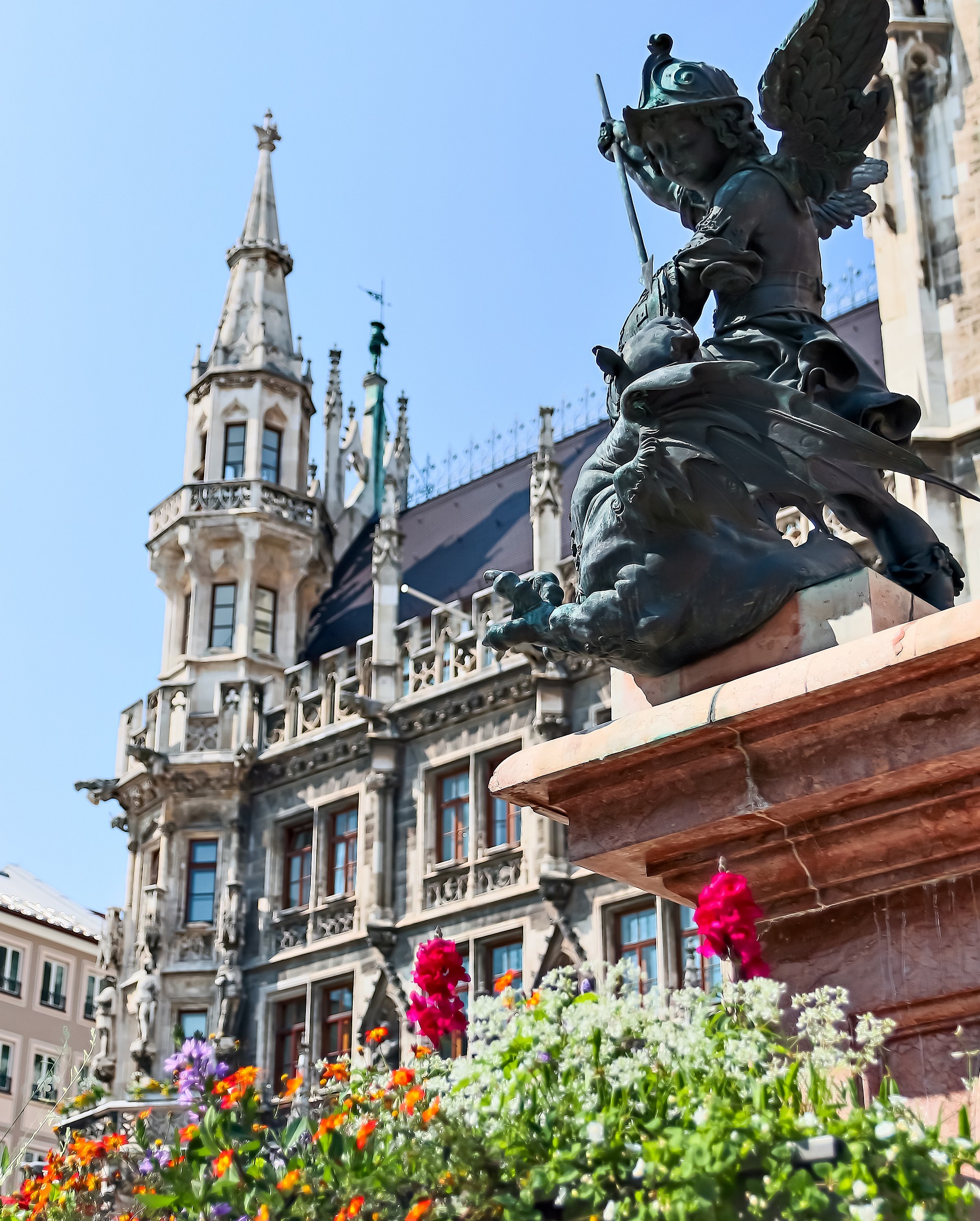
The largest and dominant building on the central square in Munich, Marienplatz, is the impressive new city hall, the Neues Rathaus. The building was constructed in Dutch Neo-Gothic style in the years 1867-1909, and it houses the city’s city council, lord mayor and central administration.
The town hall is richly ornamented on its approximately 100 meter long facade with Marienplatz. Here you can see a number of statues of, for example, Duke Henrik Løve and most of the Bavarian Wittelsbach dynasty.
The distinctive tower of the town hall, together with the twin towers of the Frauenkirche, are the most striking structures in the city center skyline. The tower is 85 meters high with the figure of the city coat of arms Münchner Kindl on top, and from here there is a lovely view.
Both on the trip up the tower and from Marienplatz, it is worth noting the town hall’s famous glockenspiel, the Rathaus-Glockenspiel, which provides a distinguished experience every day at 11:00 a.m. and 12:00 p.m. (from March to October also at 5:00 p.m.), when 32 figures turn to the sound of 43 bells strike. The carillon is divided into two floors, with the upper one retelling the wedding between Duke Wilhelm V and Renata of Lorraine in 1568. The lower part shows the so-called cooper dance/Schäfflertanz from 1517. That year the plague hit Munich, and in those difficult times the coopers reportedly danced and spread joy, new faith and loyalty to the Dukes.
The balcony of the Neues Rathaus is another well-known place for many of the city’s citizens and other Germans. This is where major events such as a football championship are celebrated in front of a large crowd on Marienplatz.
The Residenz palace complex is Munich’s old city castle, which was built over many centuries by Bavaria’s various regents; dukes, electors, emperors and kings. The building complex is the largest of its kind in Germany, and here you can partly experience fantastically beautiful rooms and halls in, for example, Rococo, Renaissance, Baroque and Neoclassicism, and partly see former royal collections on display.
Residenz today consists of three primary building parts; Alte Residenz, Königsbau and Festsaal, but there have been buildings on the site since 1385, when the city of Munich was ordered to build a smaller residence as punishment for a failed rebellion against Duke Stephan III. In the earliest times, in addition to the residence building itself, there was also a strong fortification consisting of, among other things, double walls and moats.
The Alte Residenz was established as a representative residence under Wilhelm IV in the first half of the 16th century. Later in the century, Albrecht V had the castle expanded to accommodate a newly established art collection. The collection soon became so extensive that the large, beautiful Renaissance Antiquarium was built 1568-1571 for the special placement of sculptures.
In the 17th century, Maximilian I had the west wing of the Alte Residenz built. It was the first part of the Residenz to face directly onto the streets of Munich, Residenzstraße to be precise, and it still does so with two lions at the entrance.
Under King Ludwig I, Königsbau was built with inspiration from Florence’s Palazzo Pitti in the years 1825-1835. The Königsbau is the part of the Residenz that faces Max-Joseph-Platz. The architect was Leo von Klenze, and the Königsbau housed both royal apartments and state representation halls. Today, the Königsbau houses, among other things, the Bavarian Academy of Fine Arts/Bayerische Akademie der Schönen Künste and the castle’s treasury.
The Treasury/Schatzkammer spreads over several rooms in the Königsbau, and here you can experience one of the world’s finest collections of crown jewels. Here is an abundance of royal crowns, sceptres, swords, goldsmith’s work and precious stones from the long reign of the Wittelsbach dynasty. If you are interested in several collections, one of the world’s largest coin and banknote collections is also located in the Residenz.
Leo Von Klenze was also behind the Festsaalbau, which was built in the years 1832-1842. The Festsaalbau was built in neoclassicism and faces the Hofgarten garden with its 250 meter long facade. Festsaalbau was renovated after destruction during the Second World War, and today several impressive halls are located here.
These are the imposing Herkulessal/Herkulessaal, where the Bavarian Radio Symphony Orchestra plays, and the Cuvilliés Theatre, whose original location from the opening in 1753 was elsewhere in the Residenz. However, much of the original interior has been used in the new theatre, and the place is considered one of Germany’s finest rococo theatres.
To the east in the Residenz building complex is the All Saints Court Church/Allerheiligen Court Church, which was built 1826-1837 under Ludwig I by the court architect Leo von Klenze. The church had public access from the east (towards Alfons-Goppel-Straße) and a private royal entrance directly from the Residenz.
Immediately south of the Allerheiligen-Hofkirche is the Residensteater/Residenztheater, which was built in 1950-1951 on the site of François de Cuvilliés’ original rococo theater from 1753.
The stables of the Residenz are largely unpreserved, but you can see the former Hofrideskole/Hofreitschule (Alfons-Goppel-Straße), which lies east of the Allerheiligen-Hofkirche. It was built 1817-1822.
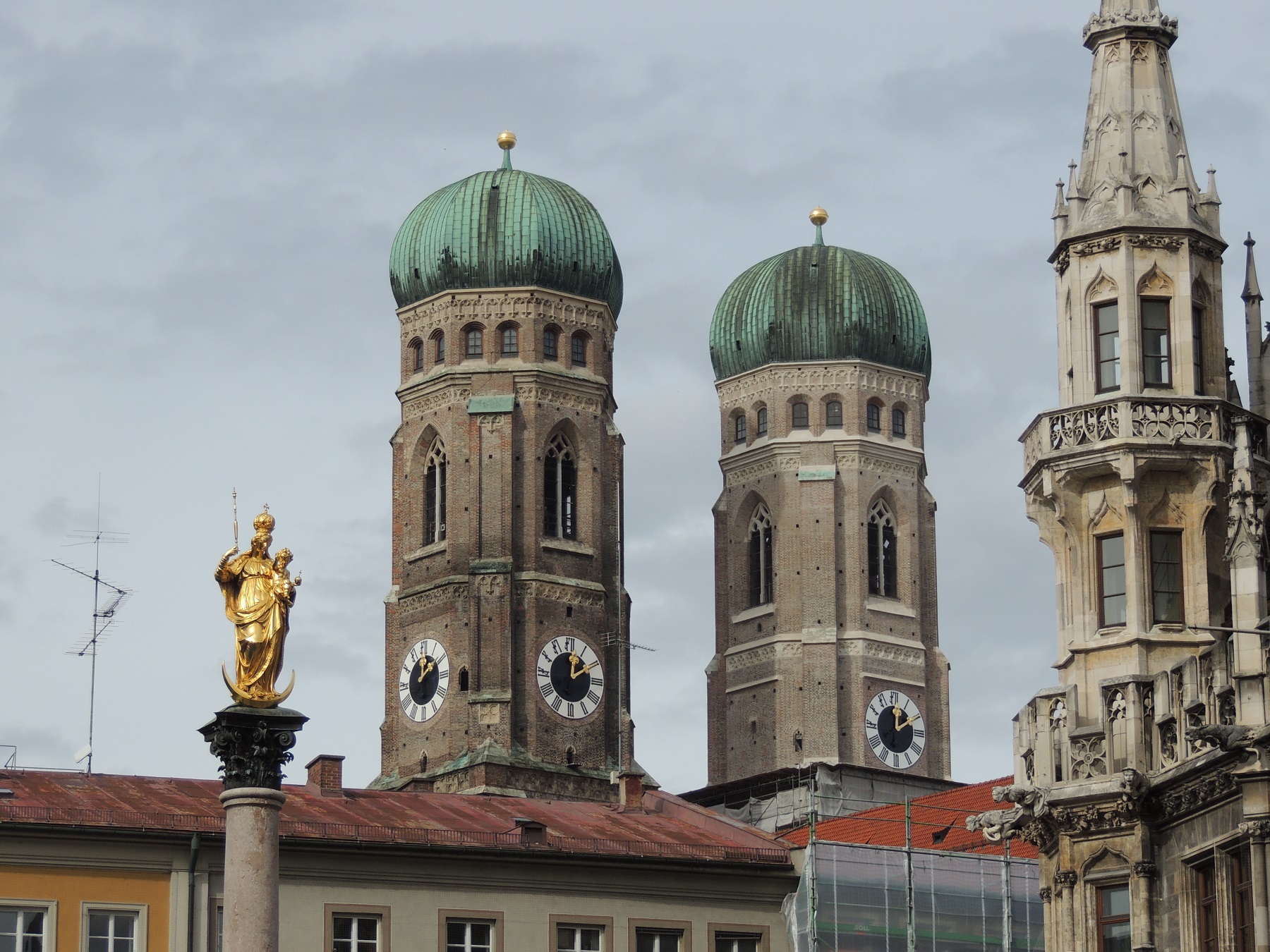
The Frauenkirche is Munich’s cathedral for the area of Munich and Freising, and it is also the city’s largest church building. The church with its characteristic two towers is also one of the landmarks of the Bavarian capital.
Already in the 12th century, a Romanesque church was built on the site. It was Munich’s second church building after “Old Peter”/”Alter Peter”. In the 15th century, Duke Sigismund decided to build a large and impressive cathedral, the Frauenkirche, which was built in the period 1468-1494. The style became Gothic, and the church was by the same architect who was behind the Altes Rathaus. For both economic and practical reasons, the church was built in brick; suitable quarries for alternatives were thought to be too far from the town.
The beautiful Frauenkirche’s 98 meter high twin towers stand as Munich’s landmark and can be seen far and wide. Their characteristic onion domes were designed with inspiration from the Mosque of the Rock in Jerusalem’s late Byzantine features and were completed in 1525 as a replacement for two originally intended tower spiers in the style of Cologne Cathedral. The towers themselves, without domes, were completed in 1488, and although it is not visible from the street, the south tower is 12 centimeters lower than the north.
Frauenkirche’s dimensions are 109 meters long, 40 meters wide and with 31 meters to the ceiling in the three naves. It is thus an impressive church space that meets you behind the doors in the facade, and it can accommodate 20,000 people. This number underlines the grandeur of the church and Duke Sigismund’s ambitions, as Munich had fewer inhabitants at the time of construction.
Inside, you notice that from certain angles the church does not seem to have many windows. A curiosity is the so-called Devil’s Footprint, Teufelstritt, which is a footprint in one of the church’s tiles shortly after the entrance from the street. From the spot, you can’t see side windows when you look at the main altar, and it is said that the Devil stood here and wondered about it.
In the Frauenkirche there are a number of works of art from the 1300-1800s, and you can also see a number of graves; among others the Holy Roman Emperor Ludwig IV. He was Duke of Bavaria before being crowned Emperor in 1328. Many dukes and Bavaria’s King Ludwig III, who ruled 1912-1918, also lie here.
The art museum Neue Pinakothek houses a distinguished collection of European painting from the 18th century to the early 20th century. Here is a special collection of German paintings from the 19th century; the most comprehensive of its kind. The museum also has works by classic English landscape painters, French impressionists and other great artists such as Gustav Klimt, Henri de Toulouse-Lautrec, Bertel Thorvaldsen and Edvard Munch.
The Neue Pinakothek was established by Bavaria’s King Ludwig I in 1853. The king had already collected contemporary art from his time as crown prince, and thus had a considerable collection for the museum’s start. The original museum building was a stately building, but it was destroyed during World War II. The current building was opened in 1981.
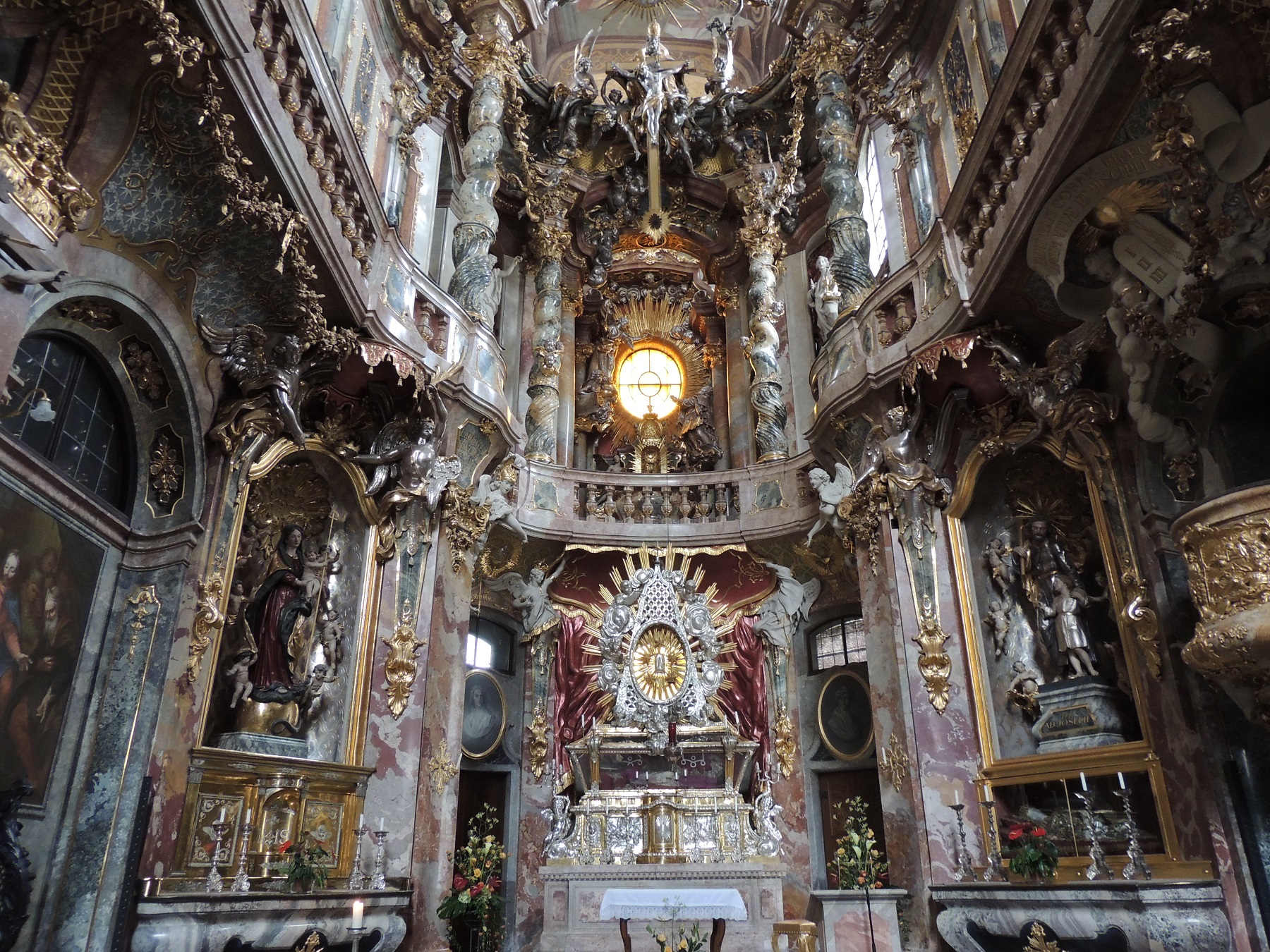
The Asamkirche is one of Munich’s most noteworthy church buildings. It was built together with the neighboring building and residence Asam Haus/Asamhaus 1733-1746 by the brothers Egid Quirin and Cosmas Damian Asam.
The lavishly decorated church is among Munich’s finest and is one of Southern Germany’s masterpieces of late Baroque architecture. As the church was built as a private church, there are various special characteristics of the building. It is, for example, that Egid Quirin Asam had a window made so that he could see the church’s altar from his home in Asamhaus.
The plot of land for the Asamkirche measures just 22×8 meters, and every square meter in the two-story church is utilized with artistic or architectural details that make a visit here a great experience. Vertically, the dark pews symbolize the suffering of the world and people, while the middle level in blue-white shades was reserved for the emperor. The upper parts with the beautiful paintings are the symbol of God and eternity.
The ceiling fresco is considered one of Cosmas Damian Asam’s major works, and the beautiful painting depicts scenes from the life of Saint John of Nepomuk.
The church’s main altar is framed by four spiral columns that were set up with inspiration from St. Peter’s Basilica in the Vatican with the corresponding columns at St. Peter’s tomb. Under the tabernacle in the Asamkirche is a relic of John of Nepomuk.
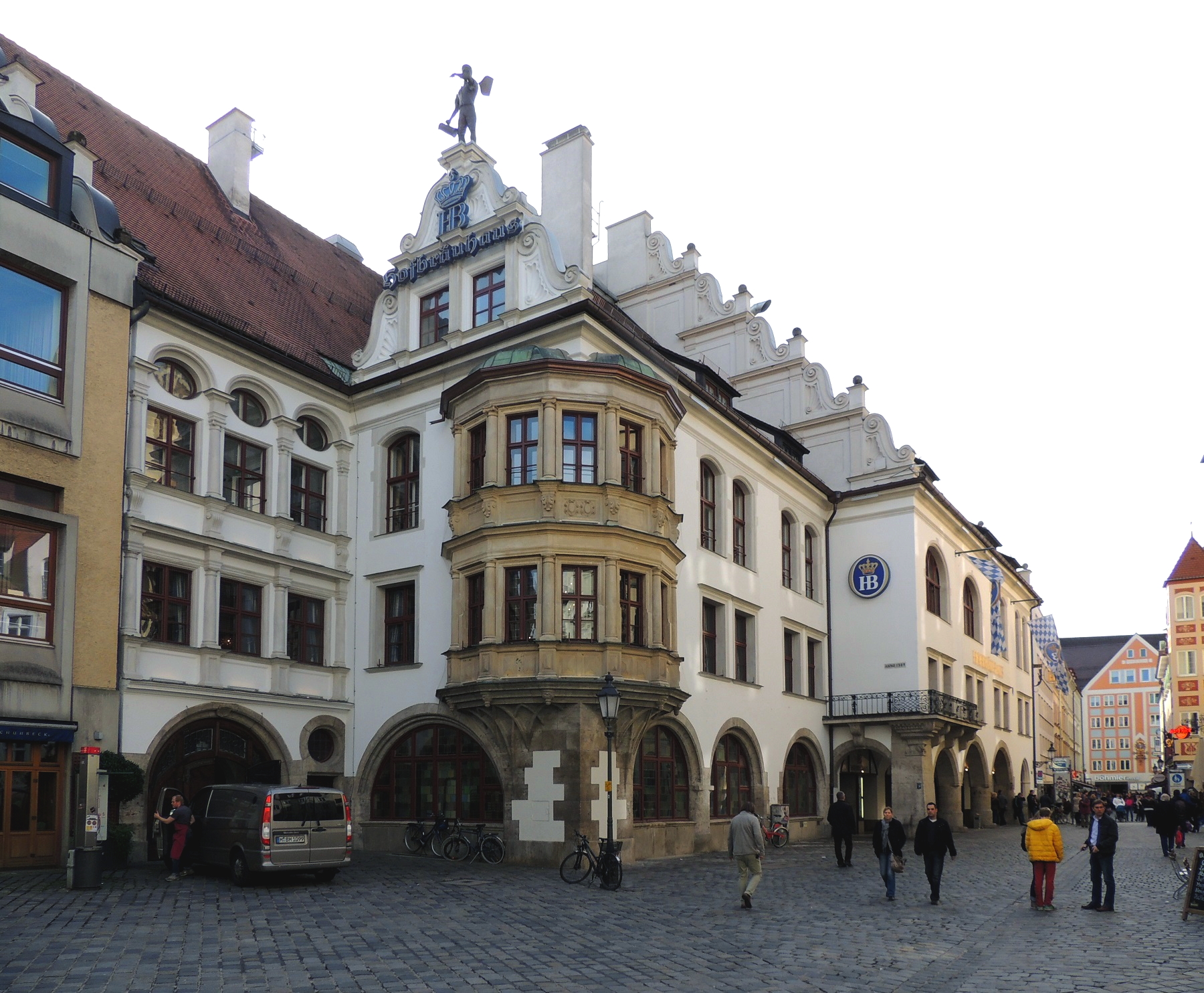
The Hofbräuhaus is a widely famous Bavarian brewery that was founded by Duke Wilhelm V in 1589 as a restaurant and brewery for the court. Since 1828, the public has had access to it, while the current buildings were built in 1896-1897.
The place entered the history books on February 24, 1920, when around 2,000 people gathered for the founding of the NSDAP, the German Nazi Party. It was the first major public gathering organized by Adolf Hitler, and on this occasion he presented the 25-point program that was to form the basis of the Nazi ideology. The meeting was held in the Festsalen/Festsal. As a curiosity, it can be mentioned that the communist Lenin often visited the Hofbräuhaus when he lived in Munich before the First World War.
Earlier than this, the beer from the Hofbräuhaus has also played a political role. When Sweden’s King Gustav Adolf besieged Munich in 1632 during the Thirty Years’ War, he refrained from ravaging and looting the city, as he got some hostages and 600,000 barrels of beer from here.
Today, both tourists and locals enjoy the fantastic atmosphere of the Hofbräuhaus. Here there is Bavarian music, lederhosen and of course the home-brewed beer.
Of the art museum Pinakothek’s three departments, the Alte Pinakothek covers the period from the Middle Ages to the 18th century, and this part of the collection is among the world’s finest of its kind. Here are a number of halls and areas according to geography and era, e.g. Venetian art, Italian Baroque painters and works by Flemish painters.
Among the countless famous masters whose works hang in the Alte Pinakothek are Albrecht Dürer, Rembrandt, Frans Hals, van Dyck, Rubens, Giotto, El Greco and Velázquez.
The beautiful museum building was built in the years 1826-1836 at the request of King Ludwig I, and it was then the world’s largest museum building. The museum’s neo-Renaissance exterior was atypical for the time, and the interior was modern with, for example, use of natural light. Thereby the museum came to provide inspiration for other 19th-century museum buildings around Europe.
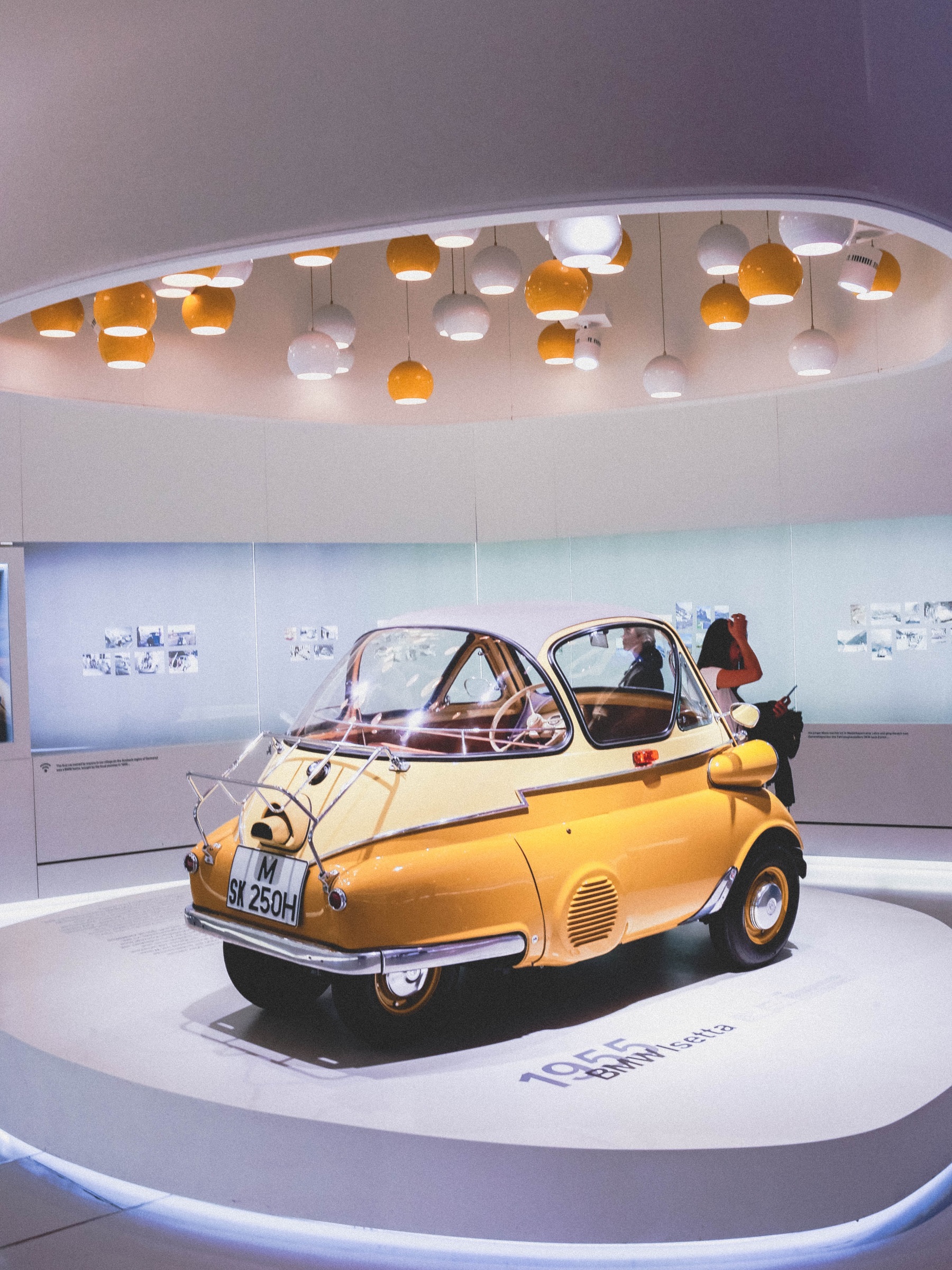
Among the many German technology companies, BMW stands as one of the largest and best known. The flagship is cars and motorcycles, and the company’s headquarters are in Munich. BMW also stands for Bayerische Motor Værk/Bayerische Motoren Werke.
BMW Welt is a fantastic car museum located at the company’s headquarters. The core is BMW’s own cars, but the entire group’s production is shown, and this also applies to cars from Rolls-Royce and MINI. At the museum you can see many of the well-known cars from BMW of the time and also get to know subjects such as motorsport and design.
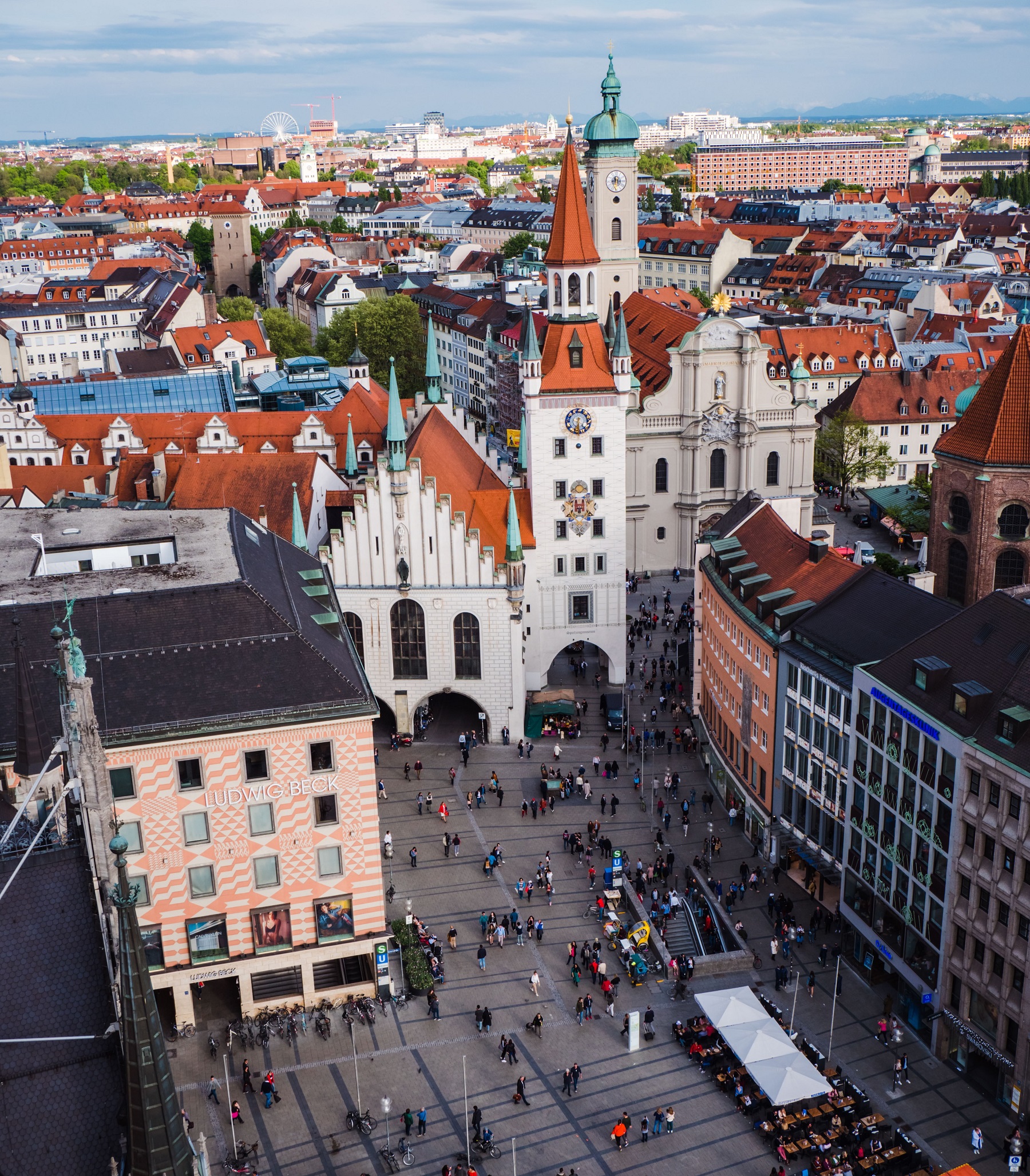
The square Marienplatz is the center of Munich, a role it has had since the city’s founding in 1158. During the first centuries, the city’s market was located here; at that time Marienplatz was called Marktplatz.
The name Marienplatz comes from the 11-metre tall Marian column/Mariensäule, which was erected on the square by Elector Maximilian I in 1638. The reason was that the city was spared during the siege by the Swedes in the Thirty Years’ War. The gilded figure of the Virgin Mary itself dates from 1590, and it originally stood in the city’s Church of Our Lady/Frauenkirche (Frauenplatz).
Sankt Michael’s Kirche is a beautiful Jesuit church that was built in 1583-1597 with the order’s main church, the Gesukirche in Rome, as inspiration. The aim was to secure a center for the Counter-Reformation, and it became a physically large centre. The dimensions of the building are 78×20 meters in ground plan with a height of over 28 meters.
The church was built at the transition between Renaissance and Baroque and became the first church north of the Alps with certain Baroque features. The church has therefore been an important source of inspiration for countless later Baroque buildings in the region.
On the richly ornamented facade, you can see a number of figures from the ruling Wittelsbach dynasty reproduced. Between the two entrance doors is a bronze statue showing the archangel Michael fighting for the faith and slaying evil in the form of a demon.
The interior of the church is one of the city’s most beautiful spaces. It feels like an elongated dome, and everywhere the ornamentation is like small independent works of art with the main altar as the center point. The large vault is also one of the world’s largest.
Among the church’s rich interior is the tomb of Prince Eugen Herzog von Leuchtenberg und Fürst von Eichstätt, who, as Napoleon’s stepson, is known in French as Eugène de Beauharnais. Eugen became prince through the marriage of Maximilian I. Joseph of Bavaria’s daughter. The tombstone was made by the Danish Bertel Thorvaldsen in 1830. You can also find King Ludwig II’s grave in the church’s crypt.
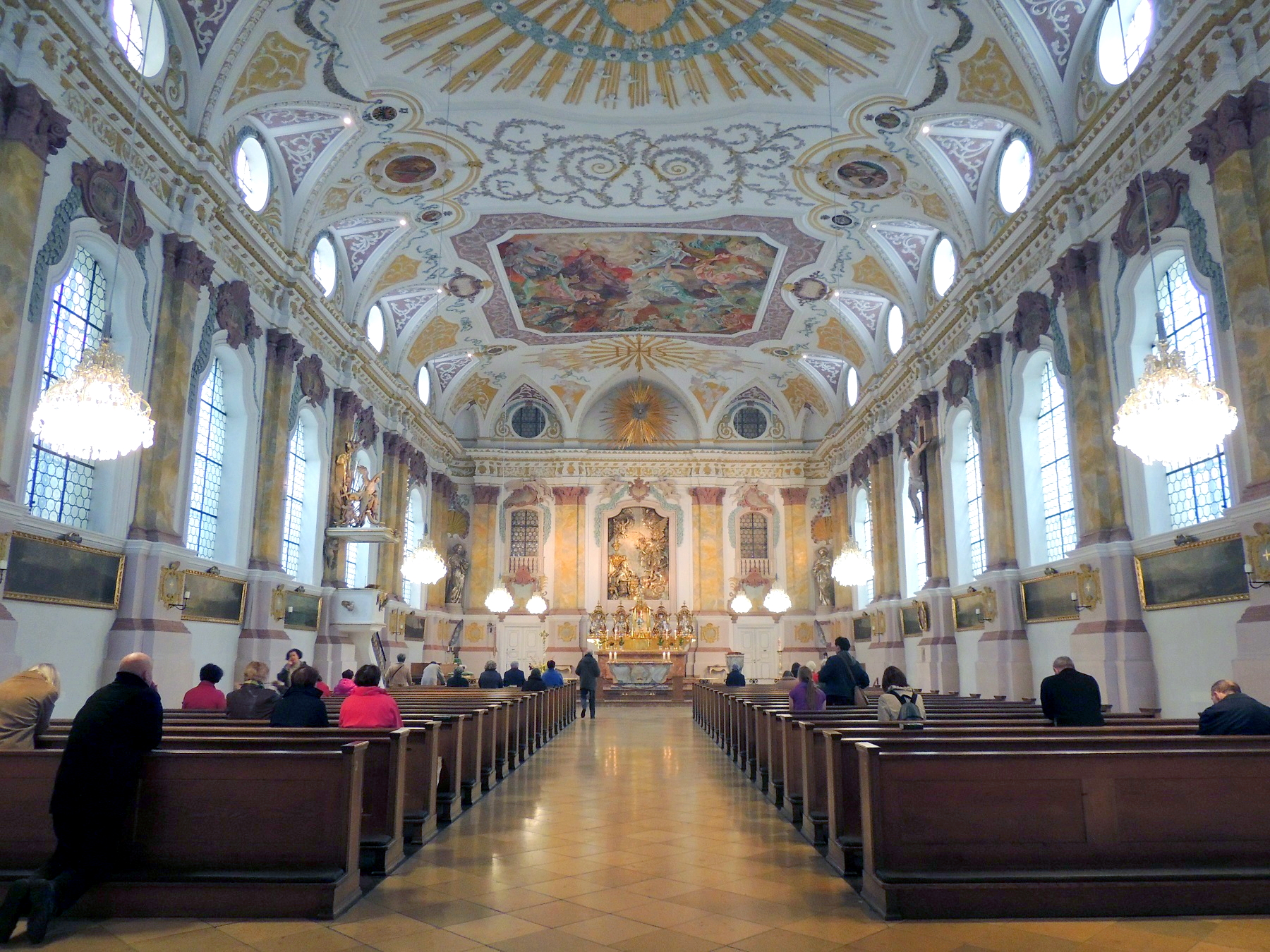
The Bürgersaal house was built in 1709-1710 after Giovanni Antonio Viscardi, and since 1778 the particularly beautifully decorated building has been a church for the so-called Marianische Männerkongregation. The association Marianische Männerkongregation was founded on 6 June 1610 as a Catholic men’s association in the preaching of Mary.
The church building consists of a lower church and an upper church. The lower church was originally a printing office for the association, and in the 19th century it was consecrated as part of the religious space. The museum of the Marianische Männerkongregation is also located here.
The upper church is located in a large room, which in its decoration is a large banquet hall from the Baroque period. The room was bombed out on the night between 24 and 25 April 1944, but has stood beautifully in its original appearance since 1959.
Münchner Stadtmuseum is a city museum where you can see exhibitions and collections that depict the city’s history in different ways. In terms of urban development, there is a permanent section where you can see, among other things, a copy of a model of the city from 1570 as well as a large number of other details from the last several centuries.
The other permanent exhibitions consist of, among other things, a photography museum, a puppet theater museum and a museum with musical instruments. If you are interested in the Nazi era in Munich, this museum is also a good place to start with the exhibition about the period 1918-1945.
The museum is interestingly arranged in the town’s former clothing store and in some of the central stable buildings. It was founded in 1888.
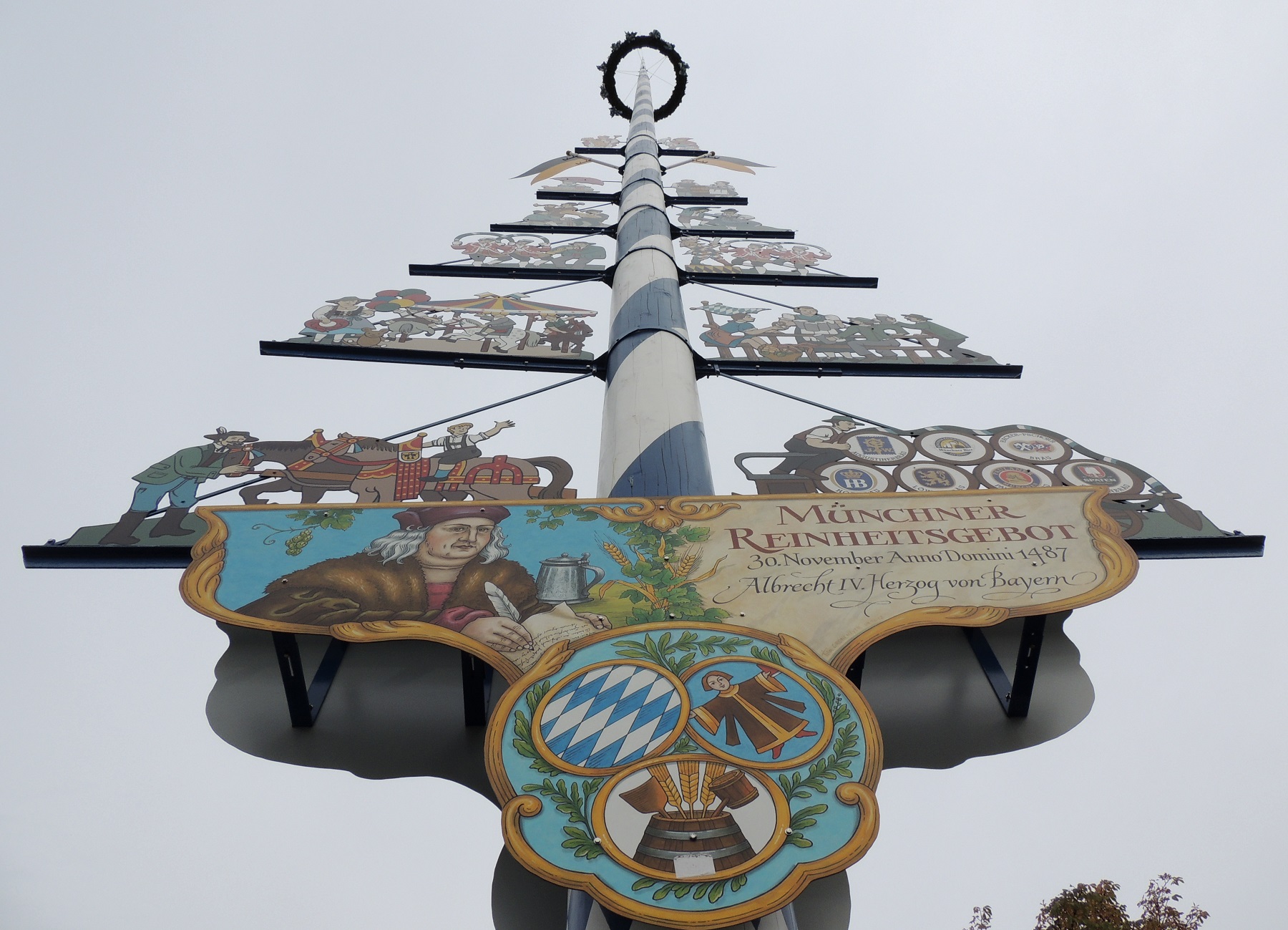
Viktualienmarkt is Munich’s food market, where you can buy many Bavarian and German specialities. The market was established in 1807 as a replacement for the market square on Marienplatz, which had gradually become too small for the city’s needs. The year before, the city had acquired what was then a former hospice at the Church of the Holy Spirit/Heilig-Geist-Kirche, which was continually demolished to make room for the new market.
From being a market for ordinary agricultural production, the Viktualienmarkt has developed into a mixture of a flower market and sales point for gourmet products such as local cheese and sausages. There are also places to eat and a Biergarten, where beer can be enjoyed in the fine atmosphere. In the middle of the square, between activities, you can see a 36-metre tall Maypole, whose many figures represent the neighborhood’s trade and crafts.
With Munich’s second city wall from the 13th and 14th centuries, the city’s area was increased fivefold to 91 hectares. The city wall had a length of about four kilometers, and along the wall there were four main gates and six smaller gates that gave access to and from the city.
The Isartor was Munich’s eastern city gate, and it dates from the 14th century fortress construction. The gate was completed in 1337 and was one of the four main gates, three of which have been preserved to this day; in addition to Isartor, it is Karlstor and Sendlinger Tor, which lie west and south-west respectively of the city centre. The fourth main gate was the Schwabinger Tor to the north.
Isartor is today restored and partially rebuilt, so that it stands as it did at the time of construction. With its impressive towers, it is a good example of the solid city defenses of the time, and it is the only one of the still standing gates that still has the central tower preserved.
Many famous people have also passed through Isartor throughout history. These are, for example, King Maximilian I in 1491, Emperor Karl V in 1530 and Sweden’s King Gustav II Adolf in 1632.
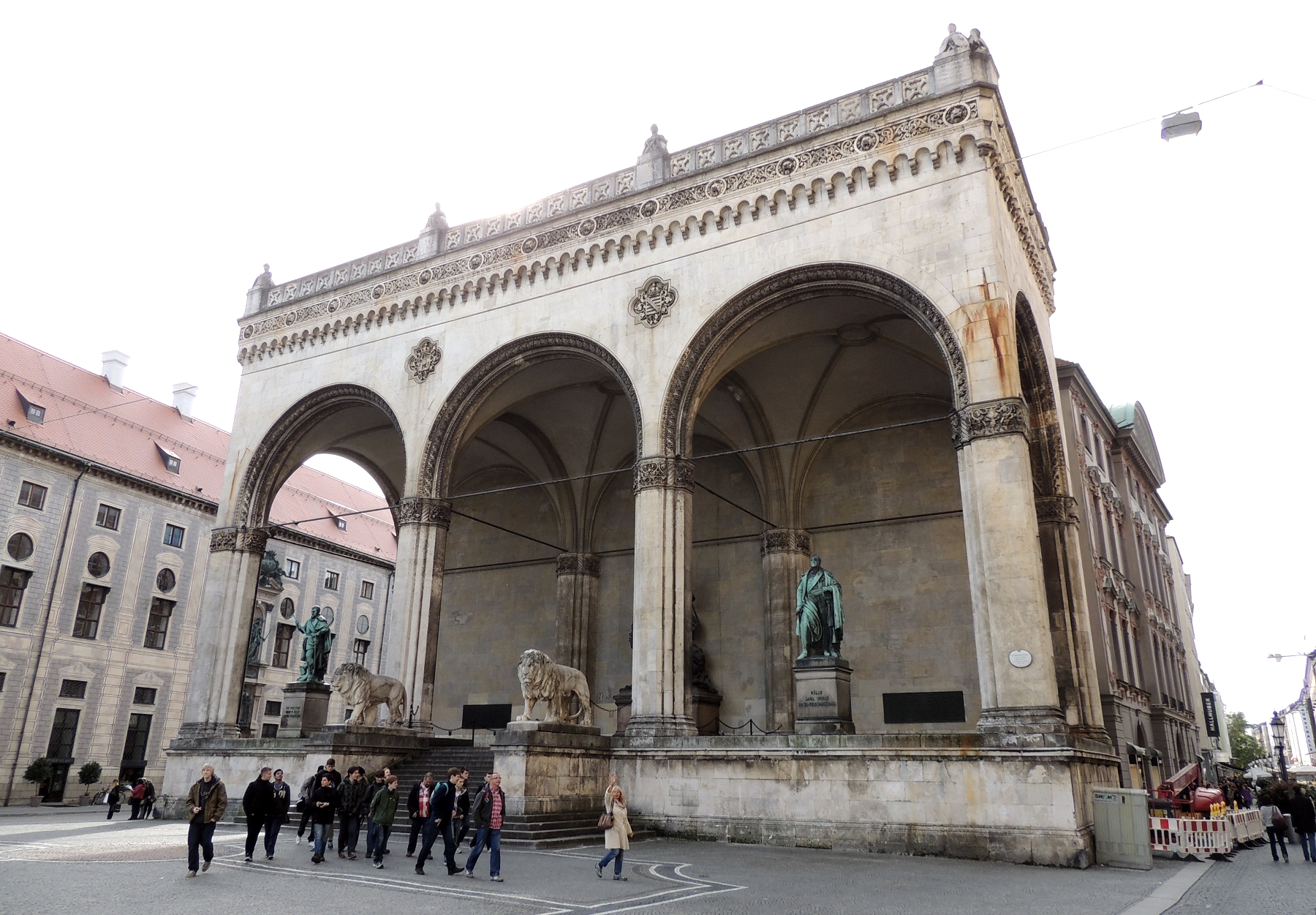
At the southern beginning of Ludwigstraße is the Feldherrnhalle, which was built in the years 1841-1844 in memory of famous Bavarian military commanders who, among other things, worked in the area during the Thirty Years’ War. The style and building is a Florentine loggia, and the Feldherrnhalle is also built with the Loggia dei Lanzi in Florence as a model.
On 9 November 1923, the German Nazi Party organized a march after Adolf Hitler’s initiation of the Beer Hall Putsch in the evening inside the city’s Bürgerbräukeller (Rosenheimer Straße 15). The march met no significant resistance at the start of the route towards Marienplatz, but it was stopped at the Feldherrnhalle by the local police, and a shootout ensued with 4 dead policemen and 14 dead Nazis as a result. On that occasion, Hermann Göring was wounded and, after escaping, Adolf Hitler was later arrested.
Haus der Kunst is an exhibition building that was built 1933-1937 as a replacement for the large glass palace, Glaspalast, which until a fire in 1931 was located in the green area immediately north of the Alter Botanischer Garten (Elisenstraße).
In the years 1937-1944 the Great German Art Exhibition/Große Deutsche Kunstausstellung was held here, and until 1939 Adolf Hitler spoke at the annual Day of German Art, Tag der Deutschen Kunst.
The Haus der Kunst’s dimensions are impressive and an expression of the Nazi monumental architecture of the 1930s. The ground surface is 175 meters in length and up to 75 in width, and on both sides there is a dominant row of columns in the facade. It was supposed to symbolize that this was a true art temple for German art. Already at the opening in 1937, the building had the form of being an experience, both with art, coziness and gastronomy, and the place was well visited. Today, the building is used for various purposes and exhibitions.
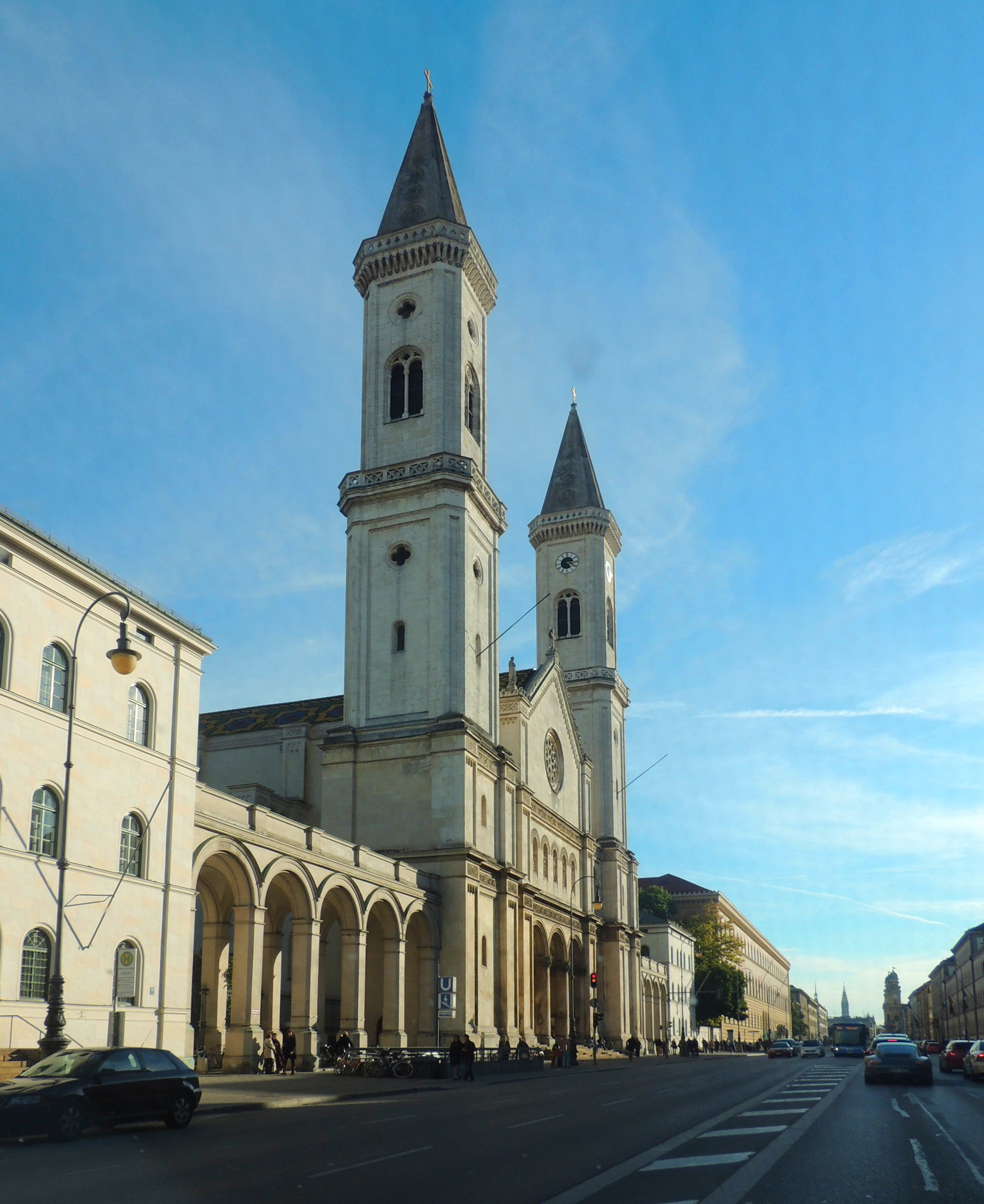
The grand Ludwigstraße was laid out in the early 1800s under Ludwig I as the city’s new and dignified access road to the center of the royal residence. The street was part of a large-scale expansion plan for Munich to the north, and it was to symbolize art, science, Roman Catholic Christianity and Bavaria’s status as a kingdom through buildings.
The impressively built street stretches from Odeonsplatz/Feldherrnhalle in the south to the Siegestor in the north. The start from Odeonsplatz was laid out from 1816 according to Leo von Klenze’s Italian Renaissance design. Further north and the Siegestor, the primary architect was Friedrich von Gärtner, whose style is the so-called round arch style, which in historicism was a particularly German-developed Romanesque-inspired direction.
A trip along Ludwigstraße is a nice stroll, where you get an impression of Munich’s royal boulevards. In total, four of these streets were laid out in the 19th century, which were to tie the city together with new extensions. In addition to Ludwigstraße, these include the neoclassical Brienner Straße, the neo-Gothic Maximilianstraße and the museum street Prinzregentenstraße.
King Ludwig I laid out the Königsplatz square as the center of the city’s art. With the fine art museums, the Glyptothek and the Staatliche Antikensammlung, on either side of Königsplatz, it is a status the place still holds.
In addition to the museums, the square’s most important building is the Propyläen gate, which was built 1848-1862. As with the square’s two museums, the style is Greek, and the intention was also to recreate a small corner of Athens here in Munich.
In the 1930s, the square was planned as and rebuilt to be the center of the Nazi ideology, which in a way started historically with the Beer Hall coup in 1923.
Königsplatz was paved with 22,000 granite stones and there was no grass as seen today. At the eastern end of the square, two 33 meter high flagpoles crowned with eagles were erected. The masts were to carry the German flags with the Nazi swastika.
The large square and wide promenade in the extension of the square were used for parades, and various buildings were erected at Königsplatz; including the Führerbau with Adolf Hitler’s local office.
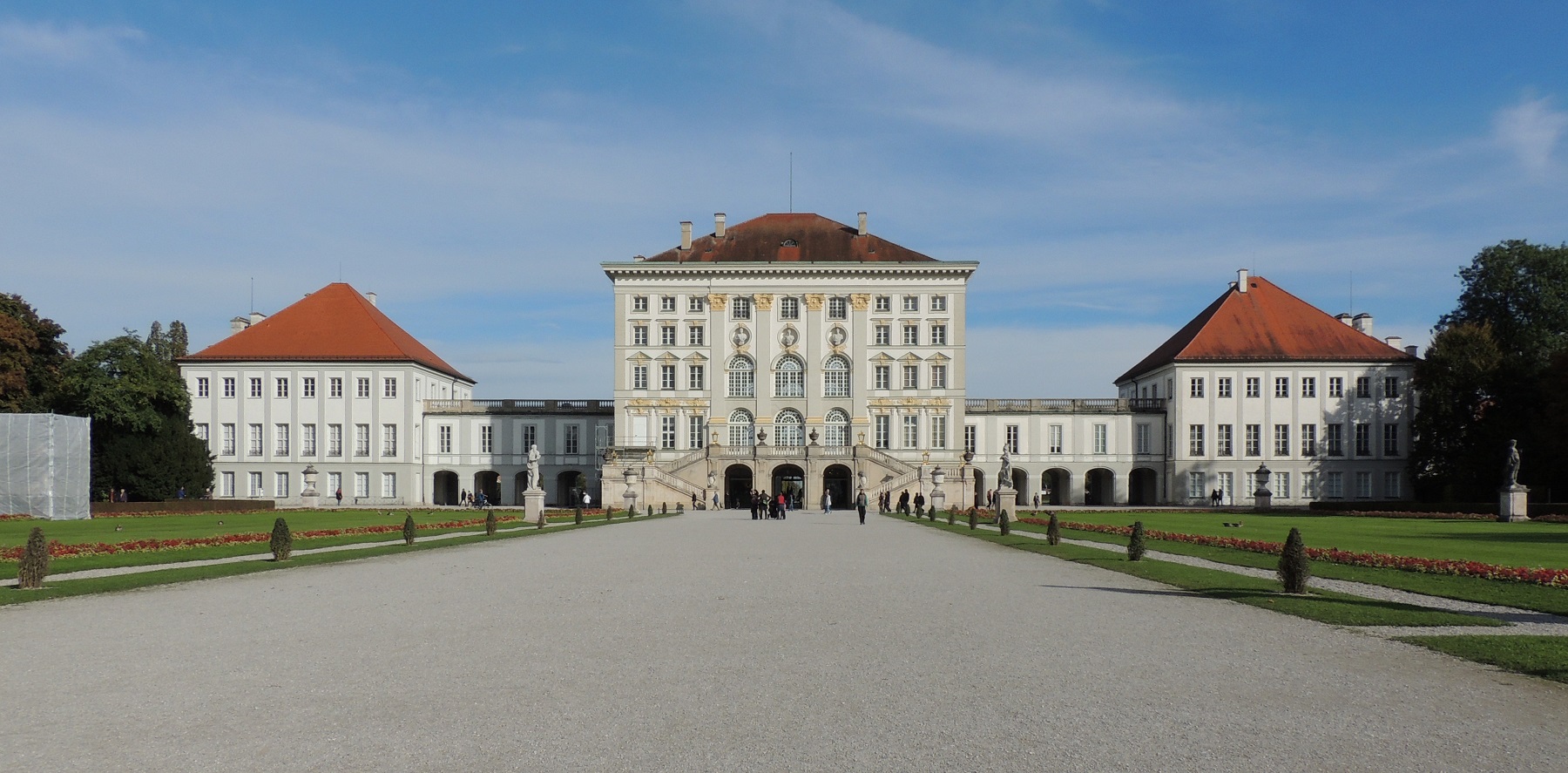
Nymphenburg is a sumptous Baroque palace in the western part of Munich. It was built in the years 1664-1675 as a gift from Elector Ferdinand Maria to his wife Adelheid von Savoyen on the occasion of their first-born son; Maximilian Emanuel. The architect behind Nymphenburg is the Italian Agostino Barelli.
Maximilian Emanuel began in 1701 a major extension of the castle. Pavilions were built for Barelli’s central castle building, and to the south stable buildings were erected as a further extension of the castle complex, offering a total of around 700 meters of impressive facade. To ensure symmetry, an orangery was added to the north. Most recently, the Slotsrondelle/Schloßrondell was built in front of the castle, and around it the so-called Kavalerhuse/Kavaliershäuschen were built.
Nymphenburg was the summer palace of the Bavarian regents for centuries, and the many halls were often rebuilt and refurnished. Today, you can find here, among other things, King Ludwig I’s famous Beauty Gallery/Schönheitengalerie, which consists of 36 portraits of the most beautiful women of the time.
In the Stensalen/Steinerner Saal in the central castle building, you can admire beautiful ceiling frescoes that were painted by, among others, Johann Baptist Zimmermann. Adjacent rooms and halls include, for example, an audience hall and private suites.
In addition to the splendor of the castle itself, there are various museums here that are worth seeing. The Staldmuseet/Marstallmuseum exhibits the royal family’s carriages over many years, while the Porcelænsamlingen/Porzellansammlung shows the local production of porcelain; a tradition that goes back to the year 1747.
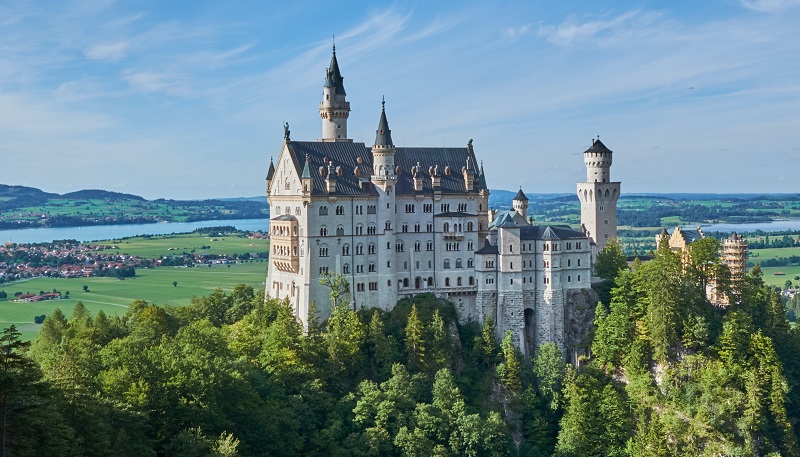
Schloß Neuschwanstein is one of Germany’s and the world’s most iconic castles. It was built at the foot of the Alps by King Ludwig II, who was also called the King of Adventures. Before the current castle, there was a castle here, and it lay in ruins until Ludwig II got the idea for Neuschwanstein. The idea was that the castle should be built as a castle from the time of the knights.
The castle was built from 1869, and it could be used in 1884. Ludwig II died two years later, and Neuschwanstein was not completely finished at this time. The missing parts were completed in a simplified design compared to the original plans.
Among the many exciting rooms in the castle, you can experience the 20×12 meter Throne Room. The model for the hall was the church Allerheiligen-Hofkirche from the Munich residence, and it is beautifully decorated with, for example, artwork in the apse. The Sangersalen/Sängersaal is the castle’s largest hall with dimensions of 27×10 metres. The prototypes are halls of the castle in the German Wartburg, and the decoration is based on themes of Lohengrin and Parzival.
From the outside, Neuschwanstein looks like a true fairytale castle with its towers and of course also the location on a mountain top with the Alps as a backdrop. The interior of the castle consists of an upper and a lower castle courtyard, surrounded by high and tower-adorned walls. At the end of the upper castle yard, the residence castle itself is located in the most prestigious place, and opposite the castle it was planned that a castle church should be built. On the pavement you can see the outline of the church that was never built.
In the town of Dachau, you can see the idyllic Dachau Castle/Schloß Dachau (Schloßstraße 7), which was the favorite country residence of the Munich court in the 18th century and thus the summer palace of the ruling Wittelsbach family. The castle building itself dates from the 16th-18th centuries, and it was created on the site where there had been a castle since the 12th century.
In Dachau there is also a concentration camp that was established in 1955 as a memorial area with the name KZ-Gedenkstätte Dachau (Alte Römerstraße 75). In the preserved buildings, the history of the place is depicted in the period 1933-1945. The camp was opened by Heinrich Himmler in 1933 to house political prisoners, and German guards surrendered to American troops on April 29, 1945.

Augsburg is a city in the state of Bavaria and the largest in the state after Munich and Nuremberg. Augsburg is also one of Germany’s oldest cities, founded by the Romans in 15 BC. with the name Augusta Vindelicorum. Augsburg was later a free imperial city of the Holy Roman Empire from 1276 to 1803. The city also played a role during the Reformation, as the Augsburg Confession was presented here in 1530. 25 years later, the Augsburg Religious Peace was adopted during the Reichstag in the city.
There are many pleasant streets and squares in the old town of Augsburg, where you can see many fine sights. Rathausplatz is the central square, and here you can see the city’s beautiful Renaissance town hall from 1620, which contains the famous hall named Goldener Saal. Next to the town hall stands the contemporary Perlachturm, which was originally built in the 900s. There is an observation deck in the tower with a nice view of the city.
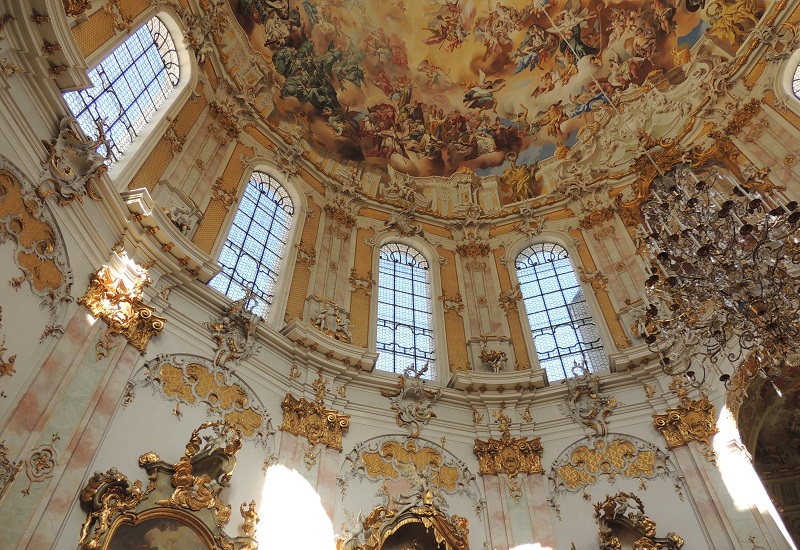
In the middle of the South German mountains is the village Ettal, which is home to a Benedictine monastery with a sumptuous abbey church. The monastery was founded on 28 April 1330 by Emperor Ludwig of Bavaria. The motives for the establishment have been partly development of the region and partly a form of imperial security and control of the trade route between Augsburg and Verona.
The monastery was active until a secularization closed the place in 1803. In 1900, Benedictine monks could move into the buildings again, and from 1907 it has again been an independent monastery with its own operations.
Today, the monastery runs many different businesses. This applies, among other things, to agriculture, accommodation and a brewery, located directly opposite the monastery complex.
The most beautiful part of the large monastery is the two-towered Mariæ Himmelfartskirke/Sankt Mariä Himmelfahrt Kirche, which in its original form dates back to the years 1330-1370, when a dodecagonal Gothic church was built. In the aftermath of the Reformation, the church was heavily damaged in 1552 after an attack by Elector Moritz von Sachsen’s troops, but it was only after a fire in 1744 that the current Baroque gem was built.
The church is located in a monastery courtyard and stands with an exterior with two towers and a large central dome beautiful with mountains as a backdrop. However, the fine exterior only becomes an unforgettable experience when you step inside. Here you are greeted by a wealth of decoration and details in elegant light shades. A highlight is Johann Jakob Zeiller’s ceiling fresco from 1746, and another is the organ built by Johann Georg Hörterich in 1768.
The Zugspitze is Germany’s highest mountain at 2,962 metres, and unlike many other Alpine peaks, the Zugspitze is easily accessible to tourists. At the top itself there are three peaks, and here there is, among other things, a restaurant and a viewing terrace.
On the summit, since 1851, there has been a cross, the Zugspitzekreuz, which was erected during an expedition 11.-13. August. The initiator was the priest Christoph Ott, and his cross stood until a repair was necessary in 1881-1882. In 1993, the cross was taken down again for repairs, but after two months it was decided to put up a copy of the original cross.
The cross measures 4.88 meters in height and stands on the eastern peak of the Zugspitze, which is marginally higher than the other two peaks, which are the middle and the western. The western peak was 2,964 meters until, during Germany’s Nazi rule, some meters were blown away in order to establish an air traffic control center, which, however, was not built.
There are several routes to the top of the Zugspitze. From the city of Garmisch-Partenkirchen, it is easiest to take the Bayerische Zugspitzbahn cog railway from the railway station. The line runs, among other things, through a 4,466 meter long mountain tunnel up to the station Zugspitzblatt, which is located at an altitude of 2,588 metres.
From here, the Gletscherbahn cable car goes the last way up to the top of the Zugspitze itself. You can also get off the train in Eibsee at an altitude of 1,008 meters and take the Eibseeseilbahn cable car to the top of the Zugspitze; you can also choose a round trip where you combine the two transport routes. Both trips are totally worth it; both on the way up and of course also when standing on the mountaintop.
If you want to take the trip towards more mountains, the 2,628 meter high Alpspitze is nearby. Alpspitze’s pyramid-shaped peak is one of the area’s landmarks, and a 3,810-metre-long cable car goes up the mountain from 750 meters to the mountain station, located at 2,033 metres.
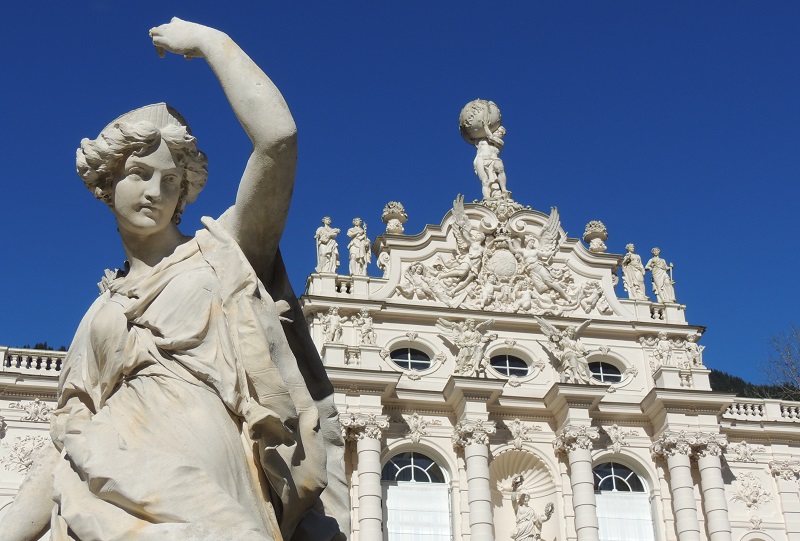
In the beautiful mountain valleys at the foot of the German Alps lies the small beautiful castle Linderhof, which was one of King Ludwig II’s residences. King Ludwig II also started the construction of two other castles in Bavaria, but Linderhof was the only one he got to see in its finished state.
When Ludwig II became king, he inherited Königshäuschen, which was located where the Linderhof is today. At first he wanted to expand the place, but he decided in 1874 to demolish the Königshäuschen and build the Linderhof.
The king himself had Linderhof built with the much larger Versailles near Paris as inspiration and model. His delight in the place is not least seen in the garden, which in addition to lakes and fountains has, among other things, an artificial stalactite cave.
The facility is very worth seeing, both as a castle with a castle garden, and also because of the location between the mountains, which almost tower right behind the castle complex, if normally only seen in other surroundings.
Chiemsee is a lake that is also called the Bavarian Sea. It forms a very beautiful natural area with many opportunities for relaxation and experiences. The biggest attractions are a trip on the lake itself with the two islands, Herreninsel and Fraueninsel, both of which offer beautiful buildings. You can sail to both islands from the town of Prien-Stock on the western shore of the lake.
The port environment in Prien itself is also very pleasant, and you can take the 1.91 kilometer long narrow-gauge railway Chiemseebahn between the station in Prien and the port in the district of Stock.
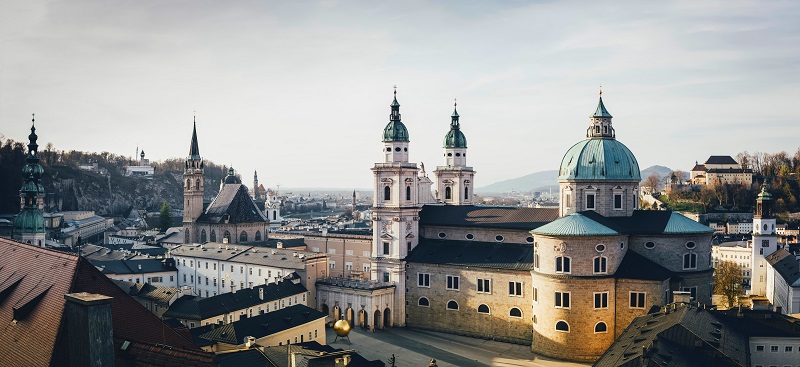
Salzburg is one of the Baroque architectural gems of the world, and as a traveler you can almost hear Mozart’s fantastic compositions in the streets. Everywhere in the old town you will be greeted by breathtaking buildings that clearly showcase the wealth the city has maintained throughout history.
The archbishops lived here and built impressive churches, fine castles and elegant squares, and as the top of everything, they laid out prestigious parks and built many sculptures to beautify the city. All this remains today, and with the city’s surroundings hills, you can easily enjoy Salzburg’s elegant skyline from several vantage points.
Theatinerstraße 15
fuenfhoefe.de
Karlsplatz 21-24
galeria-kaufhof.de
Bahnhofplatz 7, Leopoldstraße 82
hertie.de
Neuhauserstraße 18
karstadt.de
Hanauer Straße 68
olympia-einkaufszentrum.de
Ollenhauerstraße 6
einkaufscenter-neuperlach.de
Marienplatz, Karlsplatz, Neuhauserstrasse, Kaufingerstrasse, Maximilianstrasse, Residenzstrasse, Theatinerstrasse
Bavaria Filmstadt
Bavaria Filmplatz 7, Geiselgasteig
filmstadt.de
Circus Krone
Circus-Krone-Straße 1
cirkus-krone.de
Munich Zoo Hellabrun Tierpark
Tierparkstr. 30
zoo-munich.de
Märchenwald Wolfratshausen
Kräuterstraße 39, Wolfratshausen, 28 km/17 mi S
maerchenwald-isartal.de
Skyline Park
Hartfeld 1, Bad Wörishofen, 80 km/50 mi W
skylinepark.de
Wildpark Poing
Hauptstraße 29, Poing, 22 km/13 mi E
wildpark-poing.de
area of present-day Munich has been inhabited since Neolithic times. In recent times, monks came from the Benedictine Order and settled in the 7th century.
After this is meant Munich founded in 1158 by Heinrich der Löwe, who two years before had become Duke of Bavaria; a post he sat on as Heinrich XII to 1180.
1158 is at least the year Munich was first mentioned in a document, and the city’s start was the bridge over the river Isar, which Heinrich der Löwe had built just here at the Benedictine monastery. The bridge became a traveler’s only way across the river, with the Duke destroying Otto von Freising’s nearby bridge, forcing people to cross the bridge at the monastery, and they had to pay for it.
Already at a German Reichstag assembly in Augsburg in 1158, Munich’s status and rights had been established, and in 1175 Munich achieved official city status, which caused the defense works to be built around it.
In 1180, Heinrich der Löwe was deposed and replaced by Otto I. At the same time, the city had to look under the bishop of Freising. Otto I was the first ruler of the Wittelsbach dynasty to rule Bavaria until 1918.
1240 became a landmark for the city’s development, as it was here that Munich’s government officially transitioned from Freisingen’s bishop to the Wittelsbach family. In 1255, Munich was made the capital of the area’s duchies.
The next century, Munich was continuously expanded as the capital of the region, and further defense works were erected. The city wall was started in 1293, and several times the city wall was expanded so that Munich’s area could be enlarged in the same way.
At the same time, the city was experiencing a commercial boom, primarily because it was granted monopoly on salt trade by Duke Ludwig IV of Bavaria. Ludwig IV had become German king in 1314 and German-Roman emperor in 1328. It was the same Ludwig who built the Alter Hof as a residence and government complex in Munich; Alter Hof is still in the center.
In 1327 most of the city was destroyed by a fire, but that did not stop the development. Munich was both rebuilt and expanded. The trade flourished, and the city’s development was almost only slowed by plague epidemics, which ravaged the city for the first time in 1349. Large buildings were started, for example by Frauenkirche in 1468 and two years later by Alte Rathaus.
Munich and Bavaria are known today for countless good beers, and a significant part of that success was created in 1487 when the beer brewing regulations were enacted.
However, the world renowned Reinheitsgebot was first introduced by law in 1516. This law is one of the first food laws in the world as it stipulated that nothing but water, yeast, malt and hops should be included in beer. Reinheitsgebot is not a law today, but is still followed by many German brewers in their beer brewing.
By 1504, Munich’s population had grown to 13,500 and it was now a leader in Bavaria. The following year, in 1506, Munich became the capital of the entire Duchy of Bavaria, which had been reunited.
The Reformation, which was in progress in some other places in Germany in the 16th century, was not well received by Duke Wilhelm IV of Bavaria. Here Catholicism was maintained and the city became the center of anti-Reformation forces throughout the country. As a result, a number of costly construction projects were initiated, such as Residenz and Michaelskirche, which were the center of the forces against the Reformation.
By 1608, the Protestant Union had been formed as a federation of Protestant princes and cities in the German-Roman Empire to protect the religious freedom of the Protestants against the Catholic counter-Reformation. In contrast, the Catholic League was founded in Munich in 1609. The shared meaning of the two unions ended with Catholic victory at the Battle of the White Mountain during the Thirty Years’ War in 1620, thereby strengthening Catholicism in Bavaria, its capital and the Empire.
However, this did not last, as Sweden’s King Gustav II Adolf wanted to form an association of Germany’s Protestants under Sweden’s patronage and supremacy. At the same time, he wanted a closer trade and thus, in effect, a new Scandinavian-German great power based on the Protestant north. In 1630, the Swedish king began a campaign against Germany, and in 1632 Munich was besieged and looted by Sweden’s troops. Gustav II Adolf left Munich to ride north and thus away from the Bavarian capital.
After the Thirty Years’ War and new plague epidemics in 1634 and 1635, new flourishing occurred in Munich, which was culturally influenced much by the Baroque era. Prince Ferdinand Maria’s wife Henriette Adelaide invited several Italian architects to the city, and they made their mark on the city, where, among other things, the Theatinerkirche and the castle Nymphenburg were built.
In 1705-1714 Munich was under the command of the Austrian Habsburgs, and in 1742 it again came to Austrian invasion. However, peace was reestablished by Maximilian III, and through the rest of the century the focus could instead be on cultural development, for example. Thus, several educational institutions were founded in the city with the Bavarian Academy of Fine Arts as the first in 1759.
French Napoleon also influenced Munich and Bavaria. His restructuring of the German lands caused Bavaria to almost double its size, and the city became the capital of the Kingdom of Bavaria in 1806.
Four years later, Crown Prince Ludwig married Princess Terese of Saxony-Hildburghausen. That wedding was celebrated with a huge party that was exemplified by the city’s now annually recurring and famous October celebrations.
Maximilian I Joseph was crowned the first king of the kingdom to come into existence in 1918.
In 1818, the state became the first German with its own written constitution, after which the state parliament, Landdag, was created. Bavaria’s special status is in many ways preserved all the way to today’s Germany.
In 1825 Ludwig I became king, and with him a huge development started in the city of construction projects and a beginning industrialization. Among other things, Germany’s first railway was opened from here.
Today Ludwig Is’s building program is seen everywhere in Munich’s street scene, for example in the large landscaped Ludwigstrasse with the surrounding monuments and mansions. But he also wanted to make the city the cultural center. For example, the University of Bavaria was moved to the city, Residenz was expanded, Königsplatz was established and Alte Pinakothek founded.
In 1848, Ludwig I had to surrender the crown to his son Maximilian II, who initiated the great industrialization of Munich.
In 1864 Ludwig II was crowned king. He, like Ludwig I, put his great cultural and economic imprint on the city. Ludwig II initiated lavish palace buildings that are beautiful and today highly valued buildings, but they created financially difficult times for the state.
In 1871, Bavaria was incorporated into the new Germany led by Prussia. Ludwig II remained king until 1886, and during this period the city was home to, among others, Richard Wagner, Kandinsky and many other cultural figures.
Technologically, much also happened in Munich in the 19th century. For example, the railroad was opened here in 1839, trams ran in the streets of 1876 and electric lights were installed from 1882. At this time and the following decades, many great inventors had their walk in the city; this included Rudolf Diesel, Georg Ohm, Wilhelm Conrad X-ray, Albert Einstein and others.
With the start of World War I, the Allies launched a blockade of Germany, and it gave hard times. Lack of food and fuel increased and it was causing riots in the city. They culminated in November 1918 when King Ludwig III fled with his family, thereby ending Bavaria’s status as kingdoms.
In the wake of the end of the war in 1918, various rulers joined Munich; for example, a transition with communists, which Lenin, who had lived in Munich, congratulated.
However, the Weimar Republic became Germany’s tentative future and governing. In opposition to this, right-wing forces, with Adolf Hitler as the front figure, gained increasing support over the years.
In 1920, the Nazi Party held its first meeting in the city’s Hofbräuhaus, and in 1923 Munich became the venue for Adolf Hitler’s so-called beer booth. The coup was a failed attempt to overthrow the republic and seize power in Bavaria first and then Berlin and Germany. Adolf Hitler was arrested and imprisoned, but Munich was again to be the arsenal of Adolf Hitler’s Nazism, which came to power in 1933.
Munich’s significance for the Nazi triumph made the city called the Capital of Movement. The party NSDAP’s head office was located in Munich, just as many party and driver’s buildings were erected around Königsplatz. During World War II, the city was heavily damaged by bombings, but was beautifully rebuilt.
After World War II, Munich, like the rest of West Germany, quickly started economically. The city rounded out a million residents in 1957, becoming twice the center of the world’s commercial culture, in 1972 as the hometown of the Olympic Games and two years later as the venue for the final of the World Cup in football.
New museum buildings have been erected, and BMW Welt has been opened as a visit by the car group, which is one of Munich’s best-known companies; just as football in FC Bayern Munich has become among the best in the world.
 Frauenkirche, Munich[/caption]
Frauenkirche, Munich[/caption]
Overview of Munich
Munich is the beautiful and cozy capital of the southern German state of Bavaria and at the same time the northern gateway to the Alps. The city is home to world-renowned brands such as the BMW cars and the Bayern Munich football club, and it is the home of the annual Oktoberfest which is held to the delight of millions of visitors.
Dukes, kings and emperors have resided in the city over time, and they have all left their mark of the city with a lot of buildings from different architectural eras. You can enjoy castles, churches, gardens, monuments and much more. You just have to walk around the old town and in the central neighborhoods to explore it all.
The landmark Frauenkirche and the small but wonderfully decorated Asam Church are buildings among the religious highlights. City gates, plazas and large public institutions constitute other must see’s on a trip to Munich, where the 20th-century historically interested can also take a closer look at Nazi buildings such as the Führerbau.
About the Whitehorse travel guide
Contents: Tours in the city + tours in the surrounding area
Published: Released soon
Author: Stig Albeck
Publisher: Vamados.com
Language: English
About the travel guide
The Whitehorse travel guide gives you an overview of the sights and activities of the Canadian city. Read about top sights and other sights, and get a tour guide with tour suggestions and detailed descriptions of all the city’s most important churches, monuments, mansions, museums, etc.
Whitehorse is waiting for you, and at vamados.com you can also find cheap flights and great deals on hotels for your trip. You just select your travel dates and then you get flight and accommodation suggestions in and around the city.
Read more about Whitehorse and Canada
Canada Travel Guide: https://vamados.com/canada
City tourism: https://visitwhite-horse.ca
Main Page: https://www.vamados.com/
Buy the travel guide
Click the “Add to Cart” button to purchase the travel guide. After that you will come to the payment, where you enter the purchase and payment information. Upon payment of the travel guide, you will immediately receive a receipt with a link to download your purchase. You can download the travel guide immediately or use the download link in the email later.
Use the travel guide
When you buy the travel guide to Whitehorse you get the book online so you can have it on your phone, tablet or computer – and of course you can choose to print it. Use the maps and tour suggestions and you will have a good and content-rich journey.


The square Marienplatz is the center of Munich, a role it has had since the city’s founding in 1158. During the first centuries, the city’s market was located here; at that time Marienplatz was called Marktplatz.
The name Marienplatz comes from the 11-metre tall Marian column/Mariensäule, which was erected on the square by Elector Maximilian I in 1638. The reason was that the city was spared during the siege by the Swedes in the Thirty Years’ War. The gilded figure of the Virgin Mary itself dates from 1590, and it originally stood in the city’s Church of Our Lady/Frauenkirche (Frauenplatz).
Sankt Michael’s Kirche is a beautiful Jesuit church that was built in 1583-1597 with the order’s main church, the Gesukirche in Rome, as inspiration. The aim was to secure a center for the Counter-Reformation, and it became a physically large centre. The dimensions of the building are 78×20 meters in ground plan with a height of over 28 meters.
The church was built at the transition between Renaissance and Baroque and became the first church north of the Alps with certain Baroque features. The church has therefore been an important source of inspiration for countless later Baroque buildings in the region.
On the richly ornamented facade, you can see a number of figures from the ruling Wittelsbach dynasty reproduced. Between the two entrance doors is a bronze statue showing the archangel Michael fighting for the faith and slaying evil in the form of a demon.
The interior of the church is one of the city’s most beautiful spaces. It feels like an elongated dome, and everywhere the ornamentation is like small independent works of art with the main altar as the center point. The large vault is also one of the world’s largest.
Among the church’s rich interior is the tomb of Prince Eugen Herzog von Leuchtenberg und Fürst von Eichstätt, who, as Napoleon’s stepson, is known in French as Eugène de Beauharnais. Eugen became prince through the marriage of Maximilian I. Joseph of Bavaria’s daughter. The tombstone was made by the Danish Bertel Thorvaldsen in 1830. You can also find King Ludwig II’s grave in the church’s crypt.

The Bürgersaal house was built in 1709-1710 after Giovanni Antonio Viscardi, and since 1778 the particularly beautifully decorated building has been a church for the so-called Marianische Männerkongregation. The association Marianische Männerkongregation was founded on 6 June 1610 as a Catholic men’s association in the preaching of Mary.
The church building consists of a lower church and an upper church. The lower church was originally a printing office for the association, and in the 19th century it was consecrated as part of the religious space. The museum of the Marianische Männerkongregation is also located here.
The upper church is located in a large room, which in its decoration is a large banquet hall from the Baroque period. The room was bombed out on the night between 24 and 25 April 1944, but has stood beautifully in its original appearance since 1959.
Münchner Stadtmuseum is a city museum where you can see exhibitions and collections that depict the city’s history in different ways. In terms of urban development, there is a permanent section where you can see, among other things, a copy of a model of the city from 1570 as well as a large number of other details from the last several centuries.
The other permanent exhibitions consist of, among other things, a photography museum, a puppet theater museum and a museum with musical instruments. If you are interested in the Nazi era in Munich, this museum is also a good place to start with the exhibition about the period 1918-1945.
The museum is interestingly arranged in the town’s former clothing store and in some of the central stable buildings. It was founded in 1888.

Viktualienmarkt is Munich’s food market, where you can buy many Bavarian and German specialities. The market was established in 1807 as a replacement for the market square on Marienplatz, which had gradually become too small for the city’s needs. The year before, the city had acquired what was then a former hospice at the Church of the Holy Spirit/Heilig-Geist-Kirche, which was continually demolished to make room for the new market.
From being a market for ordinary agricultural production, the Viktualienmarkt has developed into a mixture of a flower market and sales point for gourmet products such as local cheese and sausages. There are also places to eat and a Biergarten, where beer can be enjoyed in the fine atmosphere. In the middle of the square, between activities, you can see a 36-metre tall Maypole, whose many figures represent the neighborhood’s trade and crafts.
With Munich’s second city wall from the 13th and 14th centuries, the city’s area was increased fivefold to 91 hectares. The city wall had a length of about four kilometers, and along the wall there were four main gates and six smaller gates that gave access to and from the city.
The Isartor was Munich’s eastern city gate, and it dates from the 14th century fortress construction. The gate was completed in 1337 and was one of the four main gates, three of which have been preserved to this day; in addition to Isartor, it is Karlstor and Sendlinger Tor, which lie west and south-west respectively of the city centre. The fourth main gate was the Schwabinger Tor to the north.
Isartor is today restored and partially rebuilt, so that it stands as it did at the time of construction. With its impressive towers, it is a good example of the solid city defenses of the time, and it is the only one of the still standing gates that still has the central tower preserved.
Many famous people have also passed through Isartor throughout history. These are, for example, King Maximilian I in 1491, Emperor Karl V in 1530 and Sweden’s King Gustav II Adolf in 1632.

At the southern beginning of Ludwigstraße is the Feldherrnhalle, which was built in the years 1841-1844 in memory of famous Bavarian military commanders who, among other things, worked in the area during the Thirty Years’ War. The style and building is a Florentine loggia, and the Feldherrnhalle is also built with the Loggia dei Lanzi in Florence as a model.
On 9 November 1923, the German Nazi Party organized a march after Adolf Hitler’s initiation of the Beer Hall Putsch in the evening inside the city’s Bürgerbräukeller (Rosenheimer Straße 15). The march met no significant resistance at the start of the route towards Marienplatz, but it was stopped at the Feldherrnhalle by the local police, and a shootout ensued with 4 dead policemen and 14 dead Nazis as a result. On that occasion, Hermann Göring was wounded and, after escaping, Adolf Hitler was later arrested.
Haus der Kunst is an exhibition building that was built 1933-1937 as a replacement for the large glass palace, Glaspalast, which until a fire in 1931 was located in the green area immediately north of the Alter Botanischer Garten (Elisenstraße).
In the years 1937-1944 the Great German Art Exhibition/Große Deutsche Kunstausstellung was held here, and until 1939 Adolf Hitler spoke at the annual Day of German Art, Tag der Deutschen Kunst.
The Haus der Kunst’s dimensions are impressive and an expression of the Nazi monumental architecture of the 1930s. The ground surface is 175 meters in length and up to 75 in width, and on both sides there is a dominant row of columns in the facade. It was supposed to symbolize that this was a true art temple for German art. Already at the opening in 1937, the building had the form of being an experience, both with art, coziness and gastronomy, and the place was well visited. Today, the building is used for various purposes and exhibitions.

The grand Ludwigstraße was laid out in the early 1800s under Ludwig I as the city’s new and dignified access road to the center of the royal residence. The street was part of a large-scale expansion plan for Munich to the north, and it was to symbolize art, science, Roman Catholic Christianity and Bavaria’s status as a kingdom through buildings.
The impressively built street stretches from Odeonsplatz/Feldherrnhalle in the south to the Siegestor in the north. The start from Odeonsplatz was laid out from 1816 according to Leo von Klenze’s Italian Renaissance design. Further north and the Siegestor, the primary architect was Friedrich von Gärtner, whose style is the so-called round arch style, which in historicism was a particularly German-developed Romanesque-inspired direction.
A trip along Ludwigstraße is a nice stroll, where you get an impression of Munich’s royal boulevards. In total, four of these streets were laid out in the 19th century, which were to tie the city together with new extensions. In addition to Ludwigstraße, these include the neoclassical Brienner Straße, the neo-Gothic Maximilianstraße and the museum street Prinzregentenstraße.
King Ludwig I laid out the Königsplatz square as the center of the city’s art. With the fine art museums, the Glyptothek and the Staatliche Antikensammlung, on either side of Königsplatz, it is a status the place still holds.
In addition to the museums, the square’s most important building is the Propyläen gate, which was built 1848-1862. As with the square’s two museums, the style is Greek, and the intention was also to recreate a small corner of Athens here in Munich.
In the 1930s, the square was planned as and rebuilt to be the center of the Nazi ideology, which in a way started historically with the Beer Hall coup in 1923.
Königsplatz was paved with 22,000 granite stones and there was no grass as seen today. At the eastern end of the square, two 33 meter high flagpoles crowned with eagles were erected. The masts were to carry the German flags with the Nazi swastika.
The large square and wide promenade in the extension of the square were used for parades, and various buildings were erected at Königsplatz; including the Führerbau with Adolf Hitler’s local office.

Nymphenburg is a sumptous Baroque palace in the western part of Munich. It was built in the years 1664-1675 as a gift from Elector Ferdinand Maria to his wife Adelheid von Savoyen on the occasion of their first-born son; Maximilian Emanuel. The architect behind Nymphenburg is the Italian Agostino Barelli.
Maximilian Emanuel began in 1701 a major extension of the castle. Pavilions were built for Barelli’s central castle building, and to the south stable buildings were erected as a further extension of the castle complex, offering a total of around 700 meters of impressive facade. To ensure symmetry, an orangery was added to the north. Most recently, the Slotsrondelle/Schloßrondell was built in front of the castle, and around it the so-called Kavalerhuse/Kavaliershäuschen were built.
Nymphenburg was the summer palace of the Bavarian regents for centuries, and the many halls were often rebuilt and refurnished. Today, you can find here, among other things, King Ludwig I’s famous Beauty Gallery/Schönheitengalerie, which consists of 36 portraits of the most beautiful women of the time.
In the Stensalen/Steinerner Saal in the central castle building, you can admire beautiful ceiling frescoes that were painted by, among others, Johann Baptist Zimmermann. Adjacent rooms and halls include, for example, an audience hall and private suites.
In addition to the splendor of the castle itself, there are various museums here that are worth seeing. The Staldmuseet/Marstallmuseum exhibits the royal family’s carriages over many years, while the Porcelænsamlingen/Porzellansammlung shows the local production of porcelain; a tradition that goes back to the year 1747.
Similar to Munich Travel Guide
